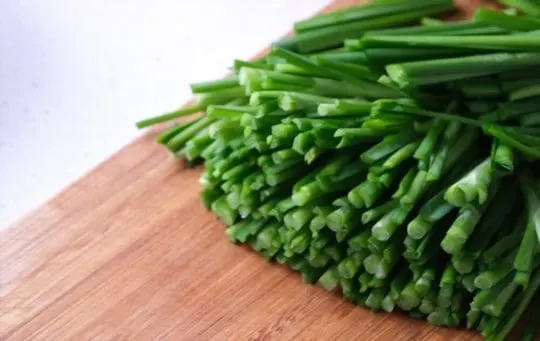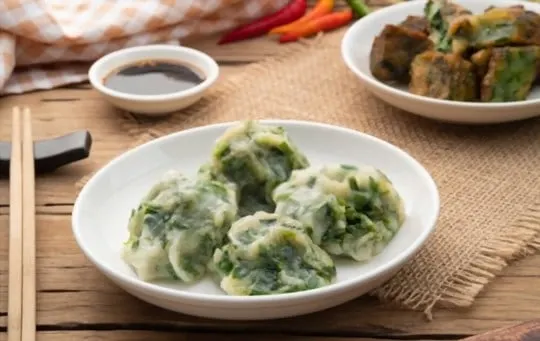In the green corner, we have chives. Tiny, but mighty in flavor.
These delicate herbs pack a punch, used to jazz up potatoes and eggs.
In the other green corner, garlic chives. Bold, with a garlicky kick.
They’re not just for aesthetics; they turn bland dishes into gourmet.
We’ve tried them both. Trust us, our dinners are never boring.
Deciding between them? It’s like picking a favorite child.
Each has its own perks. One whispers, the other shouts.
Read on to see which herb gets the crown in our kitchen.

What are Chives?

Chives are a type of herb that belong to the onion family.
These long, slender plants sprout from small bulbs and produce green, grass-like leaves with a mild onion flavor.
They’re often used as a garnish, but can also be chopped up and added to dishes like salads, soups, and omelets for extra flavor.
Chives are easy to grow and can thrive in both indoor and outdoor environments.
What are Garlic Chives?

Garlic chives are a type of herb that belongs to the onion family.
They have long, thin green leaves and a delicate garlic flavor.
These chives are mainly popular in Asia and are commonly used in Chinese, Japanese, and Korean dishes.
- They are also called Chinese chives, Oriental garlic, or Asian chives.
- Garlic chives have a slightly milder taste than regular chives but still have the distinct garlic flavor.
- They are rich in vitamins A and C and contain antioxidants that help improve digestion.
- Garlic chives can be consumed raw or cooked, and they go well with stir-fries, soups, salads, dumplings, and various sauces.
Additionally, garlic chives can be grown as ornamental plants that provide attractive flowers during their blooming season.
They thrive in well-drained soil with plenty of sunlight.
Differences Between Chives and Garlic Chives

Chives and garlic chives are two different herbs that are often used in cooking, but what sets them apart? While both belong to the Allium family and have a similar appearance, they do have some distinct differences.
Chives are known for their mild onion flavor and thin, tubular leaves, while garlic chives have a stronger garlic taste and flat, broad leaves.
Additionally, garlic chives require more sun exposure to grow compared to chives.
Furthermore, when it comes to cooking with these herbs, they can’t always be used interchangeably.
Chives work well in dishes that require subtlety like soups or salads while garlic chives add a bold flavor that complements dishes like egg rolls or stir-fries.
Appearance and Growth Habit
Chives and garlic chives differ in their appearance and growth habits.
While both have thin, long, and grass-like leaves, garlic chive leaves are flatter, broader, and have a lighter green color compared to chives.
Garlic chives also bear white flowers on taller stalks while chive flowers are wider and pinkish-purple.
When it comes to growth habits, garlic chives tend to grow larger than regular chives and can spread more quickly.
However, gardeners can control the spread of both herbs by growing them in containers or using borders.
Flavor and Aroma
The perceived taste and fragrance of fresh herbs add a unique dimension to a dish.
The distinctiveness of flavor and aroma in herbs assists in creating an unforgettable culinary experience.
From this perspective, evaluating the distinctions between chives and garlic chives can only aid in their application in various household and catering arenas.
Chives have mild onion-like flavors which can enhance the taste of different meals, whereas garlic chives exhibit more subtle garlic and herb-like qualities.
Chives are mostly used raw, providing a delicate onion taste to egg or fish dishes.
Garlic chives are most commonly infused into Asian-style cooking dishes.
Unique qualities differentiate chives from their garlic counterparts.
Although both have a distinct tangy yet mild flavor with subtle onion flavors, Garlic chives have a slightly stronger garlicky and herbal flavor compared to regular chive.
Culinary Uses
Chives and garlic chives are versatile herbs used extensively in various global cuisines.
These greens, available round the year, have a slightly different flavor profile and offer various culinary opportunities for chefs and home cooks.
While usage depends on geographic locations and cultures, the subtle differences between the two herbs can create exquisite delicacies.
Understanding these nuances is important to unleash the herbs’ full potential in cooking applications.
Chives belong to the Allium family, whereas garlic chives are part of Chinese cuisine and come from the Allium tuberosum species.
The regular chive has grass-like leaves with a delicate onion-like taste that adds mild spice to dishes.
Its flavor complements eggs, salads, dips such as sour cream or yogurt bases well.
On the other hand, garlic chives’ blade-like leaves have a slight garlicky note mixed with onion undertones; it can act as a milder version of garlic due to its mild flavor.
These qualities make them suitable for marinades or stir-fries where they won’t overpower other ingredients.
Despite their distinctiveness in taste profiles, these thin green-stems share some commonality when it comes to usage – as edible garnishing options or recipe enhancers.
People often use them interchangeably due to their close resemblance at times; however, their taste profile sufficiently ensures an enhancement of culinary performance if used appropriately.
Overall, selecting between which herb best suits your dish depends on its complementing textures and flavor palette blending well while not overpowering one another- after all, that’s what creates perfect harmony in food.
Nutritional Profiles
Chives and garlic chives are herbs with distinct nutritional profiles.
Both are low in calories and high in antioxidants, making them healthy additions to meals.
However, garlic chives have slightly more nutrients than chives since they contain higher amounts of vitamin C, magnesium and vitamins K and A.
Both herbs also have small amounts of other beneficial nutrients such as iron, calcium, folate and fiber which contribute to overall health.
In terms of taste, garlic chives have a stronger flavor than regular chives due to their sulfur compounds that give them the pungent ‘garlic’ flavor.
Additionally, garlic chives can be used in various ways such as stir-fry dishes, salads or soups whereas regular chives are mostly used for garnish purposes only.
Overall, both types of herbs provide good nutritional value and can be used for different purposes depending on preference.
It is important to note that while these herbs may enhance the taste of food, they should not be relied upon as a sole source of nutrients in the diet.
Similarities Between Chives and Garlic Chives

Both chives and garlic chives belong to the same family, but with distinct differences.
These herbs share similar characteristics which make them easy to confuse with one another.
For example, they both have a mild onion flavor that can enhance many dishes.
Additionally, both chives and garlic chives have long and narrow leaves that emerge from underground bulbs or clusters.
Another similarity between these two herbs is their versatility in cooking.
Both can be used as a garnish or for adding flavor to dishes like soups, salads, rice, eggs, potatoes among others.
However, it’s worth noting that while they might look alike and taste similar in some ways, there are also unique features that set them apart.
Chives are characterized by their grass-like leaves with a mild onion flavor; on the other hand, garlic chives boast flat leaves with a distinctive garlicky taste.
Garlic chives come in handy when you need to add an extra zing of garlicky flavor without overpowering your dish.
Cultivating Chives and Garlic Chives
Cultivating both types of Chives is easy and straightforward.
Here’s all you need to know.
- Soil Requirements: Both Chives prefer rich, well-draining soil with a pH between 6-7.
- Watering: Keep the soil moist but avoid overwatering as both Chives are susceptible to root rot.
- Sunlight: They grow best in partial shade or full sun but require at least four hours of direct sunlight every day.
- Fertilization: Use a balanced fertilizer every four to six weeks during the growing season for optimum growth.
- Propagation: Both varieties can be propagated through seeds or divisions. For divisions, separate the clumps in early spring or fall.
- Pest and Disease Control: Regularly check for aphids, thrips, and onion maggots and use organic insecticides if required. Proper spacing and good airflow can also prevent diseases such as powdery mildew and rust.
Did you know that garlic chives have flat leaves while chives have round leaves? Additionally, garlic chives are used more commonly in Asian cuisine due to their stronger flavor compared to regular chives.
Conclusion
Comparing chives and garlic chives, both are great herbs with distinct flavors.
While chives offer mild onion-like flavor with a slight sweetness, garlic chives have a garlicky flavor with a slightly bitter aftertaste.
Depending on your recipe, you can choose either of them or use them together to create an exciting blend of flavors.
To sum up, there’s no clear winner when it comes to choosing between chives and garlic chives – it all depends on what flavor you’re looking for.
So experiment with these herbs in your recipes until you find the perfect match.

Leave a comment